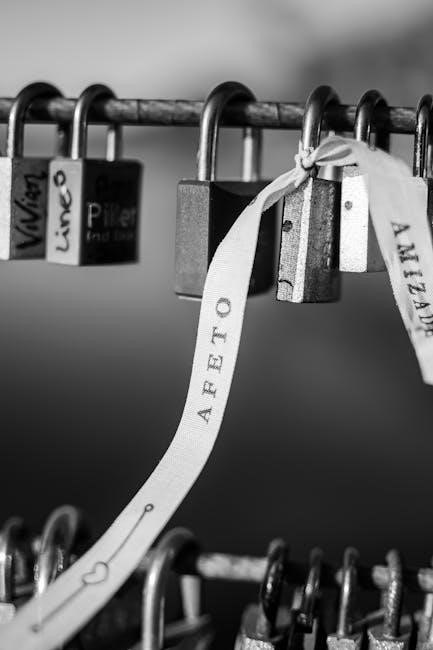Ionic bonds are chemical bonds formed through electron transfer between metals and non-metals, resulting in the formation of ions and ionic compounds․ These bonds are fundamental in chemistry, enabling the creation of stable molecules with distinct properties․ Understanding ionic bonding is essential for analyzing compound structures and their interactions in various scientific and real-world applications․
1․1 Definition of Ionic Bonds
An ionic bond is a chemical bond formed through the complete transfer of electrons between atoms, typically between metals and non-metals․ This results in the formation of oppositely charged ions: cations (positively charged) and anions (negatively charged)․ The electrostatic attraction between these ions holds them together in a rigid lattice structure, creating ionic compounds․ Ionic bonds are characterized by the transfer of electrons, unlike covalent bonds, which involve sharing․ This fundamental process is essential for understanding the formation and properties of ionic compounds․
1․2 Importance of Ionic Bonds in Chemistry
Ionic bonds are crucial in chemistry as they form the basis of ionic compounds, which are essential in various natural and industrial processes․ These compounds often exhibit high melting points and solubility in water, making them vital in biological systems and technological applications․ Ionic bonds also play a key role in understanding chemical reactivity, electrochemistry, and the periodic table trends․ Their study is fundamental for fields like materials science, medicine, and environmental chemistry, highlighting their significance in both theoretical and practical chemistry․
1․3 Brief History of Ionic Bond Discovery
The concept of ionic bonds traces back to the 19th century when scientists like Michael Faraday and Svante Arrhenius laid the groundwork for understanding ionic interactions․ Faraday’s work on electrolysis hinted at the existence of ions, while Arrhenius’s dissociation theory explained how ions form in solutions․ The modern understanding of ionic bonding was further developed in the early 20th century through the contributions of chemists like Ernest Rutherford and Niels Bohr, who clarified the atomic structure and electron transfer mechanisms․ This historical progression has shaped our current comprehension of ionic bond formation and its role in chemistry․

Formation of Ionic Bonds
The formation of ionic bonds involves the transfer of electrons between atoms, typically from metals to non-metals, resulting in the creation of positively and negatively charged ions that attract each other․
2․1 Transfer of Electrons in Ionic Bonding
The transfer of electrons is the fundamental process in ionic bonding, where one or more electrons are relocated from a metal atom to a non-metal atom․ This results in the formation of a cation (positively charged ion) from the metal and an anion (negatively charged ion) from the non-metal․ The electrostatic attraction between these oppositely charged ions forms a strong ionic bond․ This electron transfer is driven by the desire of atoms to achieve stable electron configurations, often resembling noble gas structures․
2․2 Role of Electronegativity in Ionic Bond Formation
The role of electronegativity in ionic bond formation is crucial as it determines the likelihood of electron transfer between atoms․ Electronegativity refers to an atom’s ability to attract electrons․ In ionic bonding, metals with low electronegativity tend to lose electrons and form cations, while non-metals with high electronegativity gain electrons to form anions․ A significant electronegativity difference between two elements, such as sodium and chlorine, drives the formation of ionic bonds, resulting in compounds like NaCl․ This principle helps distinguish ionic bonds from covalent bonds, where electrons are shared rather than transferred․
2․3 Formation of Cations and Anions
The formation of cations and anions is central to ionic bonding․ Metals typically lose valence electrons to form positively charged ions (cations), while non-metals gain electrons to form negatively charged ions (anions)․ For example, sodium loses an electron to become Na⁺, and chlorine gains an electron to become Cl⁻․ This electron transfer results in the formation of a stable ionic bond, as both ions achieve a noble gas electron configuration․ The process is driven by the desire for electronic stability․

Ionic vs․ Covalent Bonds
3․1 Key Differences Between Ionic and Covalent Bonds
Ionic bonds form through the complete transfer of electrons, creating oppositely charged ions held together by electrostatic forces, typically between metals and non-metals․ Covalent bonds involve sharing electrons, forming molecules with equal sharing between non-metal atoms․ Ionic compounds are usually crystalline solids with high melting points and conductivity when dissolved or molten․ Covalent compounds often exist as gases, liquids, or low-melting solids and are poor conductors․ These differences stem from electron transfer versus sharing․
3․2 Examples of Ionic and Covalent Compounds
Ionic compounds include sodium chloride (NaCl), calcium carbonate (CaCO3), and iron(III) oxide (Fe2O3), formed by electron transfer between metals and non-metals․ Covalent compounds like water (H2O), carbon dioxide (CO2), and methane (CH4) involve shared electrons between non-metal atoms․ Ionic compounds are often solids with high melting points, while covalent compounds can be gases, liquids, or solids with lower melting points, reflecting their differing bonding mechanisms and molecular structures․
3․3 When to Identify a Bond as Ionic or Covalent
A bond is ionic if it forms between a metal and a non-metal, involving electron transfer․ Covalent bonds occur between non-metals, sharing electrons․ Ionic bonds typically form when there’s a large electronegativity difference (>1․7), while covalent bonds form with smaller differences․ Ionic compounds often dissolve in water and conduct electricity, whereas covalent compounds may not․ Recognizing these patterns helps classify bonds accurately in worksheets and real-world scenarios, ensuring a strong foundation in chemistry concepts and problem-solving skills․

Ionic Bonding Practice Worksheets
Ionic bonding practice worksheets are essential for mastering the fundamentals of ionic bond formation, nomenclature, and formula writing․ They provide structured exercises to reinforce key concepts and prepare for exams or real-world applications․
4․1 Types of Worksheets for Ionic Bonding
Worksheets for ionic bonding include multiple-choice questions, fill-in-the-blanks, true/false statements, and matching exercises․ They also feature naming and formula-writing drills, crossword puzzles, and short-answer questions․ These exercises help students master concepts like electron transfer, ion formation, and compound naming․ Practice worksheets often focus on specific skills, such as identifying ions, balancing charges, or recognizing ionic compounds․ They are designed to reinforce learning, improve problem-solving abilities, and prepare students for advanced chemistry topics․ Regular practice enhances understanding and retention of ionic bonding principles․
4․2 Benefits of Using Worksheets for Learning
Worksheets for ionic bonding offer numerous learning benefits․ They promote active learning by engaging students in problem-solving and critical thinking․ Worksheets provide personalized practice, allowing students to work at their own pace and review challenging concepts․ Immediate feedback from answer keys enhances understanding and retention․ Regular use of worksheets reinforces key ideas, such as ion formation and compound naming․ They also improve problem-solving skills and build confidence in chemistry․ Worksheets are an effective tool for clarifying doubts and preparing for exams, making learning more interactive and enjoyable․
4․3 Common Mistakes in Ionic Bonding Worksheets
Common mistakes in ionic bonding worksheets include forgetting to balance charges, misnaming compounds, and incorrect formula writing․ Students often mix up cation and anion charges or neglect to apply the correct naming rules․ Another error is misidentifying ions, such as confusing alkali metals with alkaline earth metals․ Additionally, students may incorrectly calculate electron transfers or fail to recognize polyatomic ions․ Addressing these errors early improves understanding and accuracy in ionic bonding problems․ Regular practice helps minimize these mistakes and enhances overall proficiency in chemistry concepts․

Answer Key for Ionic Bonding Worksheets
The answer key provides correct solutions and explanations for ionic bonding problems, helping students verify their work and understand mistakes․ It ensures accuracy and reinforces learning․
5․1 How to Use the Answer Key Effectively
To use the answer key effectively, start by completing worksheets independently․ Compare your answers with the key to identify mistakes․ Review explanations for incorrect responses to understand where you went wrong․ Focus on recurring errors to improve weak areas; Use the key as a learning tool by studying patterns in correct answers․ Regular practice with the key enhances problem-solving skills and builds confidence in mastering ionic bonding concepts․
5․2 Understanding Common Errors in Answer Keys
Common errors in answer keys often involve incorrect charge balance or formula writing․ Students may mismatch cations and anions or forget to account for polyatomic ions․ Analyzing these mistakes helps identify learning gaps․ Reviewing the key reveals recurring issues, such as misapplying electronegativity rules or improper use of ion charges․ By addressing these errors, learners can refine their understanding and improve accuracy in ionic bonding problems․ Consistent practice with the key enhances skill mastery and reduces future mistakes․
5․3 Strategies for Improving Worksheet Accuracy
To enhance worksheet accuracy, break down problems into smaller steps and review each part carefully․ Use the periodic table to verify ion charges and formulas․ Double-check calculations and ensure charge balance in compounds․ Highlight common mistakes to avoid repetition․ Practice consistently to build familiarity with ionic bonding concepts․ By following these strategies, learners can improve their understanding and achieve higher accuracy in completing ionic bonding worksheets effectively over time․

Naming Ionic Compounds
Naming ionic compounds involves identifying the cation and anion, then combining their names; For anions, drop the ending and add “-ide․” For metals with variable charges, use Roman numerals in parentheses to indicate the charge․ This systematic approach ensures clarity and consistency in naming ionic compounds accurately․
6․1 Rules for Naming Ionic Compounds
Naming ionic compounds involves identifying the cation and anion․ Cations are typically metals and retain their elemental names, while anions are nonmetals with endings replaced by “-ide․” For metals with variable charges, Roman numerals in parentheses indicate the charge․ The cation name precedes the anion․ For example, NaCl is sodium chloride, and Fe₂O₃ is iron(III) oxide․ These rules ensure clarity and consistency in naming ionic compounds accurately, avoiding confusion in chemical communication․
6․2 Examples of Naming Ionic Compounds
Examples include naming sodium chloride as sodium chloride (NaCl) and calcium oxide as calcium oxide (CaO)․ For compounds with multiple charges, like iron(III) oxide, the name is iron(III) oxide (Fe₂O₃)․ Polyatomic ions, such as sulfate (SO₄²⁻), result in names like aluminum sulfate (Al₂(SO₄)₃)․ These examples demonstrate how cations and anions combine systematically to form clear, descriptive names for ionic compounds, ensuring accurate chemical communication and understanding․
6․3 Practice Exercises for Naming Ionic Compounds
Practice exercises involve naming compounds like NaCl (sodium chloride) and CaO (calcium oxide)․ Students identify cations and anions, such as Fe²⁺ or SO₄²⁻, and apply naming rules․ Exercises include transition metals, requiring Roman numerals, e․g․, Fe³⁺ in iron(III) oxide․ Mixed practices combine monoatomic and polyatomic ions, reinforcing understanding․ Answer keys provide feedback, highlighting common errors like incorrect charge assignments․ Regular practice solidifies naming skills, ensuring accuracy in chemical communication․

Writing Formulas for Ionic Compounds
Writing ionic formulas requires balancing charges between cations and anions․ Use subscripts to show the ratio of ions, ensuring neutrality․ Common challenges include polyatomic ions and transition metals․
7․1 Steps to Write Correct Ionic Formulas
Writing correct ionic formulas involves identifying ion charges, balancing them, and applying proper chemical rules․ Start by determining the charges of cations and anions․ Use the periodic table to find typical charges for elements․ Next, balance the charges by finding the smallest whole number ratio of cations to anions․ For polyatomic ions, include their charges and formulas in parentheses․ Ensure the formula is neutral by summing charges․ Avoid common errors like incorrect subscripts or missing parentheses․ Practice regularly to master this skill․
7․2 Balancing Charges in Ionic Compounds
Balancing charges in ionic compounds ensures the overall neutrality of the molecule․ Determine the charges of the cation and anion, then find the lowest ratio that neutralizes the compound․ For example, if a cation has a +2 charge and an anion has a -1 charge, use two anions for each cation (e․g․, CaCl₂)․ Always place the cation first and the anion second․ Verify that the total positive and negative charges are equal․ This step is crucial for writing accurate ionic formulas and avoiding common errors in compound formation․
7․3 Common Challenges in Writing Ionic Formulas
Common challenges in writing ionic formulas include correctly balancing charges and determining the correct ratio of ions․ Students often struggle with polyatomic ions, which have fixed charges and must be accounted for․ Forgetting to balance the charges or misplacing the cation and anion is another frequent error․ Additionally, recognizing when elements exhibit multiple charge states (e․g․, iron as Fe²⁺ or Fe³⁺) can complicate formula writing․ Practicing with worksheets helps overcome these challenges and improves accuracy in ionic compound formation․

Ionic Bonding and the Periodic Table
The periodic table helps predict ionic bond formation by identifying metals and nonmetals, their positions, and typical ionic charges, aiding in writing accurate ionic formulas․
8․1 Role of the Periodic Table in Ionic Bonding
The periodic table is essential for understanding ionic bonding as it organizes elements by their atomic structure and chemical properties․ Metals, typically found on the left, tend to lose electrons, while nonmetals on the right gain electrons, forming ions․ The periodic table helps identify valency, predict ionic charges, and determine the likelihood of bond formation․ This tool is invaluable for students and educators, aiding in the creation of worksheets and answer keys to master ionic bonding concepts effectively․
8․2 Identifying Ionic Bonding Patterns
The periodic table helps identify ionic bonding patterns by showing the positions of metals and nonmetals․ Metals, on the left, tend to lose electrons, forming cations, while nonmetals, on the right, gain electrons, forming anions․ Elements in the same group exhibit similar bonding behaviors, making it easier to predict ionic compound formation․ For example, alkali metals (Group 1) consistently form +1 ions, while halogens (Group 17) form -1 ions, aiding in worksheet problem-solving and answer key accuracy․
8․3 Predicting Ionic Bond Formation Using the Periodic Table
The periodic table is a powerful tool for predicting ionic bond formation․ Metals, typically on the left, tend to lose electrons and form positive ions, while nonmetals, on the right, gain electrons to form negative ions․ By analyzing the positions of elements, students can anticipate the charges of ions and the resulting ionic compounds․ This skill is invaluable for completing worksheets and matching answers in the key, as it simplifies the process of writing correct formulas and names for ionic compounds․

Real-World Applications of Ionic Bonds
Ionic bonds are essential in natural minerals, table salt (NaCl), and biological compounds like calcium phosphate in bones․ They are also key in electronics, soaps, and glass production․
9․1 Ionic Compounds in Nature
Ionic compounds are abundant in nature, forming the foundation of minerals and rocks․ For instance, limestone is primarily calcium carbonate (CaCO₃), and halite is sodium chloride (NaCl)․ These compounds are essential for Earth’s geology, influencing soil composition and ocean chemistry․ In biology, ionic compounds like calcium phosphate (Ca₃(PO₄)₂) are vital for bone structure, while table salt (NaCl) is crucial for nerve and muscle function․ Understanding these natural occurrences aids in appreciating ionic bonds’ role in shaping our environment and life processes․
9․2 Industrial Uses of Ionic Compounds
Ionic compounds play a vital role in various industries, driving innovation and production․ In manufacturing, sodium chloride (NaCl) is used for de-icing roads, while calcium carbonate (CaCO₃) is employed in construction materials․ The agricultural sector relies on ionic fertilizers like ammonium nitrate (NH₄NO₃) to enhance soil fertility․ Additionally, ionic compounds are key in electronics, such as lithium salts in batteries, and in water treatment processes to soften and purify water․ Their versatility makes them indispensable in modern industrial applications․
9․3 Biological Importance of Ionic Bonds
Ionic bonds are essential in biological systems, enabling vital processes․ They stabilize structures like bones and teeth through calcium and phosphate ions․ Nerve impulses rely on sodium and potassium ion exchanges․ Ionic bonds also facilitate enzyme function and DNA stability by maintaining proper ionic environments․ Additionally, they regulate pH balance in cells and bodily fluids, ensuring optimal conditions for biochemical reactions․ This highlights their critical role in sustaining life and health across all living organisms․
Common Misconceptions About Ionic Bonds
Many believe ionic bonds only form between metals and nonmetals, but they can also occur between nonmetals under specific conditions․ Another myth is that ionic bonds are completely different from covalent bonds, when in fact, they exist on a bonding spectrum;
10․1 Debunking Myths About Ionic Bonds
One common myth is that ionic bonds only form between metals and nonmetals, but they can also occur between nonmetals under specific conditions․ Another misconception is that ionic compounds are always brittle and soluble in water, which is not universally true․ Additionally, some believe ionic bonds are entirely different from covalent bonds, but they exist on a continuum․ Using an ionic bonds worksheet answer key PDF can help clarify these misunderstandings and provide accurate examples, such as ammonium compounds (NH4+) and some metal sulfides that are insoluble․
10․2 Clarifying Confusions Between Ionic and Covalent Bonds
A common confusion is that ionic bonds involve complete electron transfer, while covalent bonds involve sharing․ However, the distinction isn’t always clear-cut, as some bonds exhibit characteristics of both․ For example, polar covalent bonds have partial ionic character․ Using an ionic bonds worksheet answer key PDF can help students identify and differentiate these bond types by analyzing examples like NaCl (ionic) and H2 (covalent)․ This resource also clarifies that ionic compounds often form lattice structures, whereas covalent compounds typically form discrete molecules․
10․3 Addressing Misunderstandings in Ionic Bonding
Common misunderstandings about ionic bonding include the belief that all ionic bonds are equally strong or that ionic compounds only exist in solid form․ Using an ionic bonds worksheet answer key PDF, students can clarify that bond strength varies with ion charges and sizes․ Additionally, ionic compounds can dissolve in water, forming ions that conduct electricity․ These resources also help students understand that ionic bonding is a continuous process, not a fixed state, and that some compounds exhibit both ionic and covalent characteristics․

Advanced Topics in Ionic Bonding
Exploring advanced topics like lattice energy, polyatomic ions, and mixed bonding helps deepen understanding․ Worksheets and answer keys provide structured guidance for mastering these complex concepts effectively․
11․1 Ionic Bonding in Complex Compounds
In complex compounds, ionic bonding involves polyatomic ions like carbonate (CO₃²⁻) or ammonium (NH₄⁺)․ These ions form through covalent bonding within themselves but interact ionically with other ions․ Worksheets often focus on identifying and balancing these charges, ensuring students understand how to differentiate between monoatomic and polyatomic ions․ For example, calcium carbonate (CaCO₃) combines Ca²⁺ with CO₃²⁻, requiring precise charge balance․ Answer keys help clarify common mistakes, such as misidentifying ion charges or forgetting to balance the formula correctly․ Mastering these concepts is crucial for advanced chemistry topics․
- Examples: CaCO₃, NH₄NO₃
- Key challenge: Balancing charges accurately
11․2 Ionic Bonding and Crystal Lattices
In ionic bonding, ions arrange themselves into a crystal lattice, a repeating three-dimensional structure․ This lattice is stabilized by electrostatic forces between cations and anions․ Worksheets often include questions about lattice structures, such as identifying ion locations or calculating lattice energy․ Answer keys provide detailed explanations, helping students understand how lattice arrangement affects properties like hardness and conductivity․ Mastering crystal lattices is essential for analyzing ionic compound behavior and predicting their physical characteristics․
- Key concept: Electrostatic attraction in lattices
- Common exercise: Determining ion packing
- Benefit: Understanding material properties
11․3 Ionic Bonding in Mixed Ionic-Covalent Compounds
Mixed ionic-covalent compounds exhibit both bond types, with ions held by ionic bonds and atoms within ions sharing electrons covalently․ Worksheets often explore identifying such compounds and explaining their properties․ Answer keys highlight how partial ionic and covalent character influences solubility and conductivity․ These exercises help students grasp the complexity of chemical bonding in real-world substances, enhancing their ability to predict compound behavior․
- Key concept: Dual bonding nature
- Common exercise: Identifying bond types
- Benefit: Understanding compound diversity
Mastering ionic bonds is crucial for understanding chemical compounds․ This worksheet answer key provides essential insights, helping students identify compounds, write formulas, and grasp bonding principles effectively․
12․1 Summary of Key Concepts
12․2 Final Tips for Mastering Ionic Bonds
To excel in understanding ionic bonds, consistently practice identifying ion pairs and writing formulas․ Use worksheets and answer keys to refine your skills․ Focus on balancing charges and understanding electronegativity trends․ Regularly review fundamental concepts and apply them to real-world examples․ Seek clarification on confusing topics and use visual aids like the periodic table to predict bonding patterns․ By combining theoretical knowledge with practical exercises, you’ll master ionic bonds effectively․
12․3 Encouragement for Further Learning
Embrace curiosity and enthusiasm when exploring ionic bonds, as they form the foundation of chemistry․ Utilize resources like worksheets and answer keys to deepen your understanding․ Challenge yourself to explore real-world applications and advanced topics․ Persistent learning and practice will enhance your mastery of ionic bonds․ Stay motivated, as each concept unlocked brings you closer to excelling in chemistry․ Keep exploring, and enjoy the journey of discovering the intricacies of ionic bonding!

Be First to Comment